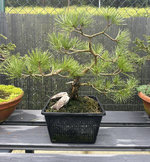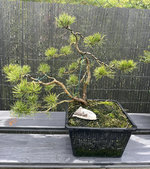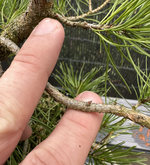Ply
Mame
I've got this Scots pine that has roots growing out of every possible hole in the bottom of the pot. Its probably 3-4 ish years old, has been in a pot since I dug it up in late February. It's in an inorganic mix (pumice-lava-granite).
If I could go back I would have just put it in a large pond basket straight away, but at the time I chose a 23cm (x11cm height) terraccota pot. The main goal right now is to thicken it's trunk and in the long run turn it into a shohin pine (its got nice low growth). Get it as vigorous as possible while letting a leader grow (Telperion style).
Reasons I'm considering putting the tree WITH its current pot it in a pond basket is to allow its roots to escape into the pond basket:
- More soil mass, more roots, more growth
- Air pruning benefit of colander (better root ramification)
- Allowing longer before a repot would be necessary (less circling of roots, clogging in original pot)
That's just in theory though, am I correct in seeing these benefits? And when would be the best time to do this? AFAIK fall is prime root growth season for pines, but perhaps already too late?
If I could go back I would have just put it in a large pond basket straight away, but at the time I chose a 23cm (x11cm height) terraccota pot. The main goal right now is to thicken it's trunk and in the long run turn it into a shohin pine (its got nice low growth). Get it as vigorous as possible while letting a leader grow (Telperion style).
Reasons I'm considering putting the tree WITH its current pot it in a pond basket is to allow its roots to escape into the pond basket:
- More soil mass, more roots, more growth
- Air pruning benefit of colander (better root ramification)
- Allowing longer before a repot would be necessary (less circling of roots, clogging in original pot)
That's just in theory though, am I correct in seeing these benefits? And when would be the best time to do this? AFAIK fall is prime root growth season for pines, but perhaps already too late?



